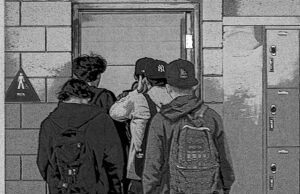Stripping Restrooms to Their Core

Internal ideology is everything. A person’s beliefs and biases color the white spaces of their world. However, once something is painted and this metaphorical paint dries, it’s difficult to see the object as the plain white which it originally was. Such is the case with bathrooms in America.
A bathroom is nothing more than a room in which persons defecate or urinate. As a society, Americans have projected their shared ideology onto their bathrooms (e.g. the importance of the separation of the genders by a binary, the importance of having a penis to embrace masculinity by using said penis to stand up and urinate, etc.) to an extreme degree.
To strip bathrooms of their ideology and to make them inclusive of every person would make them genderless. As such, they would be a single room with only stalls and sinks, and the walls of the stalls would go directly to the floor leaving no room for even mild knowledge of the user’s genitalia. People of any or no gender could use a restroom without their gender, or lack thereof, from being attacked. But creating such a bathroom is problematic.
Ideology isn’t just a collection of individual, independent opinions, it’s a brick wall which builds onto itself. Ideology becomes dependant on the ideology it’s spawned from: the brick below it. In America, the concept that sex is the determinant factor of gender is an ideological brick incredibly close to our core, despite gender and sexhaving two seperate defintions. To achieve genderless, inclusive restrooms requires the demolishment of American ideology, both Liberal and Conservative, brick by brick.
However, the wall must be demolished with care. The Overton Window, or the social window of political possibility, will only allow so much activism. By pushing outside of the window, even the most progressive American will feel his ideology threatened and deny the argument. Questions must be asked that stir stale American ideology. Questions as the Mississippi bathroom dilemma is the start of this long road.


